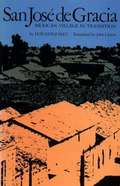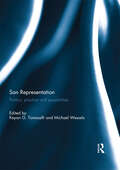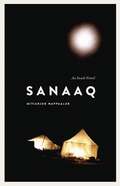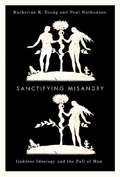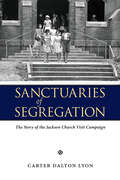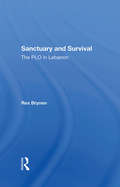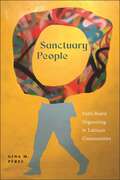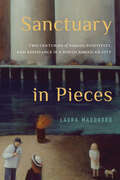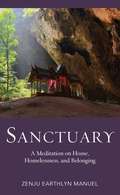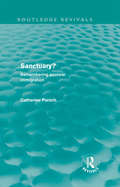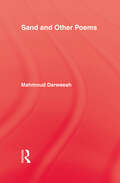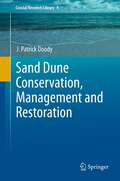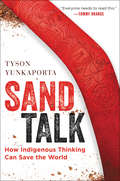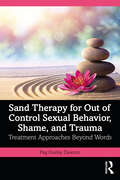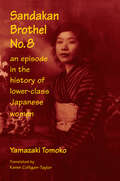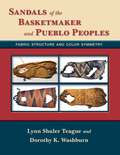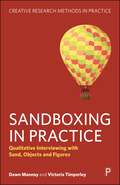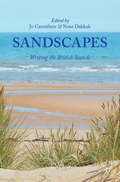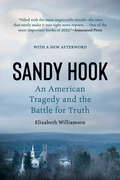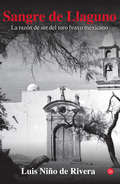- Table View
- List View
San José de Gracia: Mexican Village in Transition
by John Upton Luis GonzálezThe village of San José de Gracia is not mentioned in any history of Mexico, nor is it referred to in any of the annals of the state of Michoacán. It is not to be found at all on most maps, and almost none show its correct location. It is an unknown point in space, in time, and in the consciousness of the Mexican republic. In Luis González's classic history of the world of San José, he turns his attention in every direction: toward what is lasting and what is ephemeral, everyday and unusual, material and spiritual. The story is, to some extent, the story of rural life anywhere, in any age; to some extent it is peculiar to the world of the peasant all through Mexico's history; and to some extent it can be said to be true only of San José. The history of San José is also the history of the village as victim of the megalopolis, not only in Mexico but everywhere in our time. With the small community will be lost traditions and a sense of continuity that may prove irreplaceable and essential to human well-being. While Luis González does not suggest that he knows what the fate of San José will be, one feels that he knows all too well, and that his questions are only "How?" and "How soon?"
San Representation: Politics, Practice and Possibilities
by Michael Wessels Keyan G. TomaselliThe San or Bushmen of southern Africa have exerted a fascination over generations of writers and scholars, from novelists and anarchists to ethnologists and geneticists, and also occupy a special place in the popular imagination as the First People and the contemporary remnant of spiritual and natural man. The ways in which particular groups of people from southern Africa have been traditionally categorised and positioned as objects of scrutiny by a range of academic disciplines is increasingly being contested and questioned. There is a growing awareness of the cultural, economic and genetic entanglement of the peoples of the region. This book examines how San and Khoe people are represented, by others, as well as by those who identify as San or Khoe. The book interrogates the ways in which disciplines, through their methodologies and ways of authorising knowledge, not only "discover" or "reveal" knowledge but produce it in ways that involve complex and often ambiguous relationships with power structures and forms of intellectual, symbolic and cultural capital. One major trend that emerges is that the San and Khoe can no longer be seen as people of the past but have to be acknowledged as contemporary and socially situated individuals and communities who are increasingly contesting the representations which others have imposed on them. This book was originally published as a special issue of Critical Arts: A Journal of South-North Cultural and Media Studies.
Sanaaq: An Inuit Novel
by Mitiarjuk Nappaaluk Bernard Saladin D'Anglure Peter FrostSanaaq is an intimate story of an Inuit family negotiating the changes brought into their community by the coming of the qallunaat, the white people, in the mid-nineteenth century. Composed in 48 episodes, it recounts the daily life of Sanaaq, a strong and outspoken young widow, her daughter Qumaq, and their small semi-nomadic community in northern Quebec. Here they live their lives hunting seal, repairing their kayak, and gathering mussels under blue sea ice before the tide comes in. These are ordinary extraordinary lives: marriages are made and unmade, children are born and named, violence appears in the form of a fearful husband or a hungry polar bear. Here the spirit world is alive and relations with non-humans are never taken lightly. And under it all, the growing intrusion of the qallunaat and the battle for souls between the Catholic and Anglican missionaries threatens to forever change the way of life of Sanaaq and her young family.
Sanctified Sex: The Two-Thousand-Year Jewish Debate on Marital Intimacy
by Noam Sachs ZionSanctified Sex draws on two thousand years of rabbinic debates addressing competing aspirations for loving intimacy, passionate sexual union, and sanctity in marriage. What can Judaism contribute to our struggles to nurture love relationships? What halakhic precedents are relevant, and how are rulings changing? The rabbis, of course, seldom agree. Underlying their arguments are perennial debates: What kind of marital sex qualifies as ideal—sacred self-control of sexual desire or the holiness found in emotional and erotic intimacy? Is intercourse degrading in its physicality or the highest act of spiritual/mystical union? And should women or men (or both) wield ultimate say about what transpires in bed? Noam Sachs Zion guides us chronologically and steadily through fraught terrain: seminal biblical texts and their Talmudic interpretations; Talmud tales of three unusual rabbis and their marital bedrooms; medieval codifiers and mystical commentators; ultra-Orthodox rabbis clashing with one another over radically divergent ideals; and, finally, contemporary rabbis of varied denominations wrestling with modern transformations in erotic lifestyles and values. Invited into these sanctified and often sexually explicit discussions with our ancestors and contemporaries, we encounter innovative Jewish teachings on marital intimacy, ardent lovemaking techniques, and the art of couple communication vital for matrimonial success.
Sanctifying Misandry
by Katherine K. Young Paul NathansonHow some feminists have used religion to turn the "Fall of Man" into the fall of men.
Sanctifying Misandry: Goddess Ideology and the Fall of Man
by Katherine K. Young Paul NathansonHow some feminists have used religion to turn the "Fall of Man" into the fall of men.
Sanctions And Sanctuary: Cultural Perspectives On The Beating Of Wives
by Dorothy A Counts Judith K Brown Jacquelyn C CampbellBringing together evidence from 15 Western and non-Western societies - ranging from hunter-gatherers to urban Americans - this book examines wife-beating from a worldwide perspective. Cross-cultural comparison aims to give a more accurate picture of cultural influences on wife-battering and to show the commonalities and differences of the phenomeno
Sanctuaries of Segregation: The Story of the Jackson Church Visit Campaign
by Carter Dalton LyonWinner of the 2017 Eudora Welty PrizeSanctuaries of Segregation provides the first comprehensive analysis of the Jackson, Mississippi, church visit campaign of 1963-1964 and the efforts by segregationists to protect one of their last refuges. For ten months, integrated groups of ministers and laypeople attempted to attend Sunday worship services at all-white Protestant and Catholic churches in the state's capital city. While the church visit was a common tactic of activists in the early 1960s, Jackson remained the only city where groups mounted a sustained campaign targeting a wide variety of white churches.Carter Dalton Lyon situates the visits within the context of the Jackson Movement, compares the actions to church visits and kneel-ins in other cities, and places these encounters within controversies already underway over race inside churches and denominations. He then traces the campaign from its inception in early June 1963 through Easter Sunday 1964. He highlights the motivations of the various people and organizations, the interracial dialogue that took place on the church steps, the divisions and turmoil the campaign generated within churches and denominations, the decisions by individual congregations to exclude black visitors, and the efforts by the state and the Citizens' Council to thwart the integration attempts.Sanctuaries of Segregation offers a unique perspective on those tumultuous years. Though most churches blocked African American visitors and police stepped in to make forty arrests during the course of the campaign, Lyon reveals many examples of white ministers and laypeople stepping forward to oppose segregation. Their leadership and the constant pressure from activists seeking entrance into worship services made the churches of Jackson one of the front lines in the national struggle over civil rights.
Sanctuary And Survival: The Plo In Lebanon
by Rex BrynenThis book analyses the Palestine Liberation Organization's (PLO) "Lebanese era" and its aftermath, of the changing position of the Palestinian nationalist movement in Lebanon. It presents the PLO's efforts to maintain for itself a secure political and military base of operations in Lebanon.
Sanctuary People: Faith-Based Organizing in Latina/o Communities
by Gina M. PérezExplores ways faith communities offer protection and services for Latina/o communitiesThe New Sanctuary Movement is a network of faith-based organizations committed to offering safe haven to those in danger, often in churches, often outside the law, and often at risk to themselves. The practice of sanctuary, with its capacity to provide safety, shelter, and protection to society's most vulnerable, gained significant prominence after the 2016 presidential election and the ushering in of particularly harsh anti-immigration policies.Since 2017, Ohio has had some of the highest numbers of public sanctuary cases in the nation. Sanctuary People explores these sanctuary practices in Ohio and locates them in broader local and national efforts to provide refuge and care in the face of the challenges facing Latina/o communities in a moment of increased surveillance, migrant detention, displacement, and economic and social marginalization. Pérez argues for a conceptualization of sanctuary that is capacious, placing support of Puerto Ricans displaced in the wake of Hurricane Maria within the broader practices of sanctuary and expanding our understandings of the movement that addresses the precarious conditions of Latinas/os beyond migration status.Based on four years of ethnographic research and interviews at the local, state, and national levels, Sanctuary People offers a compelling exploration of the ways in which faith communities are creating new activist strategies and enacting new forms of solidarity, working within the sometimes conflicting ideological space between religion and activism to answer the call of justice and live their faith.
Sanctuary in Pieces: Two Centuries of Flight, Fugitivity, and Resistance in a North American City (McGill-Queen's Refugee and Forced Migration Studies #17)
by Laura MadokoroOver the past two decades, the Sanctuary City movement has resulted in hundreds of jurisdictions declaring themselves safe spaces for undocumented migrants and people without status. Although they often draw on historical precedent, public sanctuary efforts amongst settler societies are markedly different from how refuge was conceptualized in the past.To explore these broad shifts, Sanctuary in Pieces looks at the history of protection and hospitality in Montreal/Mooniyaang/Tiohtià:ke over two hundred years. Laura Madokoro traces the movements and experiences of fugitives from slavery, wanted criminals, internationally renowned anarchists, and war resisters before turning to instances of public sanctuary practices since the 1970s. As people sought and forged refuge, they navigated a web of social connections, political agendas, and economic realities, testing the notion of the city and whom it was for. Even as those in search of sanctuary imagined, and often enacted, possible futures in the city, sanctuary was far from easy: it lay in an underground marked by refusal and denial, selective compassion and solidarity, and sometimes outright animosity. This contested and tumultuous history offers a profound challenge to the symbolism and substance of contemporary sanctuary city efforts.Conceptually innovative, Sanctuary in Pieces speaks to activist and policy considerations in the present, the making and unmaking of community, and how historical practice can accommodate silence in studies of intimate experiences of mobility and, on occasion, refuge.
Sanctuary: A Meditation on Home, Homelessness, and Belonging
by Zenju Earthlyn ManuelA singular work of poetic prose exploring otherness and belonging—and what it means to be truly at home.Sanctuary: A Meditation on Home, Homelessness, and Belonging examines the interface between inner and outer sanctuary, and the ways they affect one another. “Sanctuary” is the home we can return to when our lives are under threat, where we can face what's difficult to love, and have a place where we can truly say, “I am home”—and spiritual teachers often emphasize sanctuary’s inner dimensions, that “our true home” is within. “Homelessness,” in turn, can be viewed as a forced experience or one in which there is a spiritual void in being or feeling home. Drawing from her life as a Zen Buddhist priest whose ancestors labored as slaves in Louisiana, Zenju Earthlyn Manuel explores the tension between oppression—based on race, religion, ability, class, orientation, gender, and other “ghosts of slavery”—and finding home within our own hearts. Through intimate personal stories and deep reflection, Manuel helps us see the moment when what has gone unacknowledged surfaces is “the time we have been practicing for,” the epiphany when we can investigate the true source what has been troubling us. This insightful book about home and homelessness, sanctuary and refuge offers inspiration, encouragement, and a clear-eyed view of cultivating a spiritual path in challenging times.
Sanctuary?: Remembering postwar immigration (Routledge Revivals)
by Catherine PanichIn the ten years immediately following the Second World War, some 170 000 immigrants from Europe and Britain arrived in Australia. First published in 1988, this unique book recreates the experiences of those who fled a ravaged Europe to seek a new life in far-distant Australia. Their stories are told in the words of the people themselves, supplemented with photographs, documents, press reports and memorabilia. These stories of over 100 Australians, New and Old, stories sometimes humorous and often very moving, provide a fascinating insight into a significant moment in Australian history. As the first definitive examination of life in the migrant camps, it documents a part of Australian history in danger of vanishing without trace. Never before has there been such a collection of intensely personal accounts of what it was like to pass through the immigration centres and workers’ hostels on the way to building new lives – and to shaping present-day Australia.
Sand & Other Poems
by DarweeshFirst published in 1986. Routledge is an imprint of Taylor & Francis, an informa company.
Sand Dune Conservation, Management and Restoration
by J. Patrick DoodyThis book deals with the development of temperate coastal sand dunes and the way these have been influenced by human activity. The different states in which the habitat exists both for the beach/foredune and inland dune are reviewed against the pressures exerted upon them. Options for management are considered and the likely consequences of taking a particular course of action highlighted. These options include traditional approaches to the conservation and management of wildlife and landscapes as well as habitat restoration. The way the value of the areas changes under different management regimes is considered mainly from an environmental perspective. Consideration is given to new approaches to management and restoration including adopting a more dynamic approach. Audience This book will be of interest to academics, students and professionals concerned with policy formulation and /or actively managing coastal areas.
Sand Kings Of Oman
by O'SHEAFirst published in 2001. Routledge is an imprint of Taylor & Francis, an informa company.
Sand Talk: How Indigenous Thinking Can Save the World
by Tyson YunkaportaA paradigm-shifting book in the vein of Sapiens that brings a crucial Indigenous perspective to historical and cultural issues of history, education, money, power, and sustainability—and offers a new template for living.As an indigenous person, Tyson Yunkaporta looks at global systems from a unique perspective, one tied to the natural and spiritual world. In considering how contemporary life diverges from the pattern of creation, he raises important questions. How does this affect us? How can we do things differently?In this thoughtful, culturally rich, mind-expanding book, he provides answers. Yunkaporta’s writing process begins with images. Honoring indigenous traditions, he makes carvings of what he wants to say, channeling his thoughts through symbols and diagrams rather than words. He yarns with people, looking for ways to connect images and stories with place and relationship to create a coherent world view, and he uses sand talk, the Aboriginal custom of drawing images on the ground to convey knowledge. In Sand Talk, he provides a new model for our everyday lives. Rich in ideas and inspiration, it explains how lines and symbols and shapes can help us make sense of the world. It’s about how we learn and how we remember. It’s about talking to everyone and listening carefully. It’s about finding different ways to look at things.Most of all it’s about a very special way of thinking, of learning to see from a native perspective, one that is spiritually and physically tied to the earth around us, and how it can save our world.Sand Talk include 22 black-and-white illustrations that add depth to the text.
Sand Therapy for Out of Control Sexual Behavior, Shame, and Trauma: Treatment Approaches Beyond Words
by Peg Hurley DawsonThis book is designed to educate sex therapists and mental health professionals on the power of using sand when treating sexual issues, providing guidance in accessing their clients’ unconscious to seek new ways of healing. Uniquely integrating sex therapy with sand therapy, Dawson describes how understanding and applying non-pathological theories and neuroscience to different modalities, such as Internal Family Systems and Polyvagal Theory, can help clients move forward from shame, sexual dysfunctions, and trauma. The book begins by introducing how therapists can use sand as a doorway into using metaphor and imagery in their practice, with information on how the nervous system keeps somatic experiences trapped in the body being explored. Written in an easy, accessible style, the book also includes handouts, belief cards, and case studies throughout to help therapists see the benefits of using sand with clients in practice. Including forewords by Dr. Lorraine Freedle and Doug Braun-Harvey, this book is geared toward mental health professionals, such as sex therapists and marriage and family therapists, who are working with individuals and couples seeking treatment from complex trauma and mental and sexual health issues. It will appeal to students as well as advanced mental health clinicians looking to expand their therapeutic tool kit.
Sandakan Brothel No.8: Journey into the History of Lower-class Japanese Women (Sandakan Brothel Ser. #Vol. 8)
by Tomoko Yamazaki Karen F. Colligan-TaylorThis is a pioneering work on "karayuki-san", impoverished Japanese women sent abroad to work as prostitutes from the 1860s to the 1920s. The narrative follows the life of one such prostitute, Osaki, who is persuaded as a child of ten to accept cleaning work in Sandakan, North Borneo, and then forced to work as a prostitute in a Japanese brothel, one of the many such brothels that were established throughout Asia in conjunction with the expansion of Japanese business interests. Yamazaki views Osaki as the embodiment of the suffering experienced by all Japanese women, who have long been oppressed under the dual yoke of class and gender. This tale provides the historical and anthropological context for understanding the sexual exploitation of Asian women before and during the Pacific War and for the growing flesh trade in Southeast Asia and Japan today. Young women are being brought to Japan with the same false promises that enticed Osaki to Borneo 80 years ago. Yamazaki Tomoko, who herself endured many economic and social hardships during and after the war, has devoted her life to documenting the history of the exchange of women between Japan and other Asian countries since 1868. She has worked directly with "karayuki-san", military comfort women, war orphans, repatriates, women sent as picture brides to China and Manchuria, Asian women who have wed into Japanese farming communities, and Japanese women married to other Asians in Japan.
Sandals of the Basketmaker and Pueblo Peoples: Fabric Structure and Color Symmetry
by Lynn Shuler Teague Dorothy Koster WashburnThe decorated sandals worn by prehistoric southwesterners with their complex fiber structures and designs have been dissected, described, and interpreted for a century. Nevertheless, these artifacts remain mysterious in many respects. Teague and Washburn examine these sandals as sources of information on the history of the people known as the Basketmakers.The unique sandals of early southwestern farmers appear in Basketmaker II and reach their greatest elaboration with the complex fabric structures and colorbanded designs of Basketmaker III. The appearance of this footwear coincides with the transition to fully sedentary maize agriculture. The authors address the origins of these sandals and what they may reveal about population movements onto and around the Colorado Plateau and about the cosmology of early farmers.
Sandboxing in Practice: Qualitative Interviewing with Sand, Objects, and Figures (Creative Research Methods in Practice)
by Dawn Mannay Victoria TimperleyThis is the essential guide to the innovative qualitative research technique of sandboxing. Originating from play therapy, sandboxing enables children, young people, and adults to create three-dimensional scenes using miniature figures and everyday objects in a sand-filled tray. Creating these sand scenes offers opportunities for individuals and groups to reflect on and represent memories, everyday experiences, and ideas about the future, which are then shared and discussed. Offering an invaluable resource for students, researchers, and practitioners, this comprehensive book: - introduces a creative and engaging approach to qualitative data generation; - features key international case studies, real-world examples, and thoughtful reflections on the method's strengths and limitations; - equips readers with the tools needed to effectively implement sandboxing in their research journey. By drawing on creativity, reflexivity, ethics and expertise this book unlocks sandboxing's potential to transform your research with an inventive and imaginative approach.
Sands of Time: Ancient Life in the Late Miocene of Abu Dhabi, United Arab Emirates (Vertebrate Paleobiology and Paleoanthropology)
by Andrew Hill Faysal Bibi Brian Kraatz Mark J. BeechThis monograph presents the results of over 10 years of paleontological and geological survey in the Baynunah Formation of the United Arab Emirates. Exposed widely in western Abu Dhabi Emirate, the Baynunah Formation and its fossils provide the only record of terrestrial environments and evolution in the Arabian Peninsula during the late Miocene epoch (12-5 Ma). This volume describes new fossils collected since 2002, presented systematically by taxon, and including mammals, reptiles, and invertebrates, as well as fossil trackways. The discoveries are framed within the results of new geological, geochemical, and geochrononological analyses, providing an updated and synthetic view of the age, environments, and biogeographic relationships of this important fossil assemblage.
Sandscapes: Writing the British Seaside
by Jo Carruthers Nour DakkakSandscapes: Writing the British Seaside reflects on the unique topography of sand, sandscapes, and the seaside in British culture and beyond. This book brings together creative and critical writings that explore the ways sand speaks to us of holidays and respite, but also of time and mortality, of plenitude and eternity. Drawing together writers from a range of backgrounds, the volume explores the environmental, social, personal, cultural, and political significance of sand and the seaside towns that have built up around it. The contributions take a variety of forms including fiction and nonfiction and cover topics ranging from sand dunes to sand mining, from seaside stories to shoreline architecture, from sand grains to global sand movements, from narratives of the setting up of bed and breakfasts to stories of seaside decline. Often a symbol of aridity, sand is revealed in this book to be an astonishingly fertile site for cultural meaning.
Sandy Hook: An American Tragedy and the Battle for Truth
by Elizabeth WilliamsonBased on hundreds of hours of research, interviews, and access to exclusive sources and materials, Sandy Hook is Elizabeth Williamson&’s landmark investigation of the aftermath of a school shooting, the work of Sandy Hook parents who fought to defend themselves, and the truth of their children&’s fate against the frenzied distortions of online deniers and conspiracy theorists. On December 14, 2012, a gunman killed twenty first-graders and six educators at Sandy Hook Elementary School in Newtown, Connecticut. Ten years later, Sandy Hook has become a foundational story of how false conspiracy narratives and malicious misinformation have gained traction in society. One of the nation&’s most devastating mass shootings, Sandy Hook was used to create destructive and painful myths. Driven by ideology or profit, or for no sound reason at all, some people insisted it never occurred, or was staged by the federal government as a pretext for seizing Americans&’ firearms. They tormented the victims&’ relatives online, accosted them on the street and at memorial events, accusing them of faking their loved ones&’ murders. Some family members have been stalked and forced into hiding. A gun was fired into the home of one parent. Present at the creation of this terrible crusade was Alex Jones&’s Infowars, a far-right outlet that aired noxious Sandy Hook theories to millions and raised money for the conspiracy theorists&’ quest to &“prove&” the shooting didn&’t happen. Enabled by Facebook, YouTube, and other social media companies&’ failure to curb harmful content, the conspiracists&’ questions grew into suspicion, suspicion grew into demands for more proof, and unanswered demands turned into rage. This pattern of denial and attack would come to characterize some Americans&’ response to almost every major event, from mass shootings to the coronavirus pandemic to the 2020 presidential election, in which President Trump&’s false claims of a rigged result prompted the January 6, 2021, assault on a bastion of democracy, the U.S. Capitol. The Sandy Hook families, led by the father of the youngest victim, refused to accept this. Sandy Hook is the story of their battle to preserve their loved ones&’ legacies even in the face of threats to their own lives. Through exhaustive reporting, narrative storytelling, and intimate portraits, Sandy Hook is the definitive book on one of the most shocking cultural ruptures of the internet era.
Sangre de Llaguno. La razón de ser del toro bravo mexicano
by Luis Niño de RiveraLa crónica imprescindible para todos aquellos que aman la Fiesta Brava en MéxicoEn esta nueva edición, corregida y aumentada, Luis Niño de la Rivera se basa en una extensa documentación para contar la historia de los hermanos Llaguno, quienes hace poco más de un siglo fundaron la ganadería emblemática de la fiesta brava en nuestro país.A partir de unas cuantas reses bravas traídas de España, los hermanos Llaguno se empeñaron en lograr en su crianza la bravura y el trapío necesarios para la buena lidia. Con ello lograron desarrollar el toro que ha sostenido la tauromaquia mexicana durante los últimos cien años. Varios de los más famosos toreros y ganaderos constataron los resultados logrados a partir de muchos años de empeño indomable, de intuición y trabajo, no exento de fallas y sinsabores pero siempre tenaz. Luis Niño de Rivera cuenta las andanzas, logros y tropiezos de Antonio y Julián Llaguno, los colores de sus épocas ylos minuciosos registros de crianza que les permitieron convertirse en éxitos ganaderos y personajes de leyenda.
